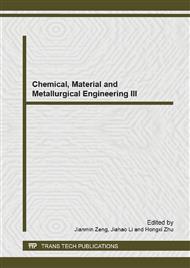p.1642
p.1647
p.1655
p.1660
p.1665
p.1670
p.1674
p.1679
p.1683
Floating Separation between Collophanite and Dolomite Affected by Inorganic Interaction
Abstract:
According to the type of Guizhou marine sedimentary phosphorus ore, the main reason of refractory is the similar surface properties of collophane and dolomite.In addition,the interaction of dissolved components of mineral and external ion leads the new eguilibrium system in aqueous solution,which further affects the selective adsorption of the agent in mineral surface.Selecting collophanite-dolomite system as the research object, this article studies the effect of the interaction of some inorganic anions on the floatability difference of the two minerals in the flotation system. The effect of the interaction on the electric properties of the mineral surface and adsorption characteristics were also examined with the purpose to find out the interaction mechanism.It hopes to provide theoretical basis for practical mineral selection. The research findings shows that in the range of pH 3 to 5, the interaction of PO43- and SO42- has a better effect of the separation between collophanite and dolomite.The interactions of SiO32- and CO32- makes the floatability difference of collophanite and dolomite closer when the pH is greater than 9.25, and simultaneously shows some negative effects on the flotation separation of the two minerals.
Info:
Periodical:
Pages:
1665-1669
Citation:
Online since:
January 2014
Authors:
Keywords:
Price:
Сopyright:
© 2014 Trans Tech Publications Ltd. All Rights Reserved
Share:
Citation:


